
Time for another trip in the Wayback machine to look at the 1981-83 Imperial, courtesy of my friend Jim Smith. He thoughtfully took pictures of brand new luxury cars back when Brougham was still in, the tops were padded and opera lamps were expected!
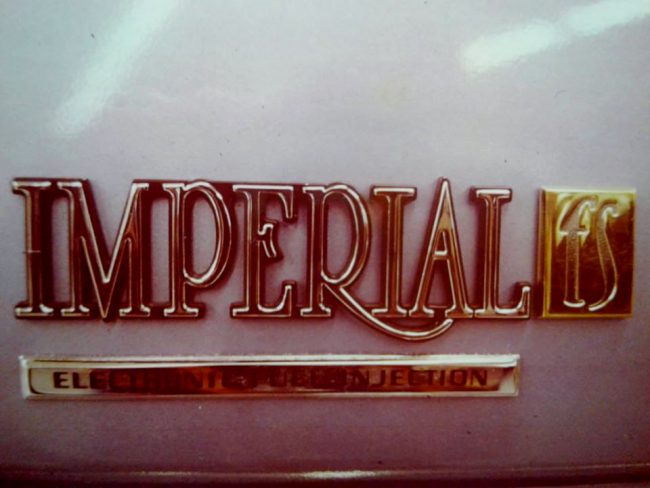
The 1981 Imperial was Lee Iacocca’s last try at the Continental Mark III formula: Long, low, sleek, with every available convenience, a long hood, a short deck, and Broughamed out to the gills.
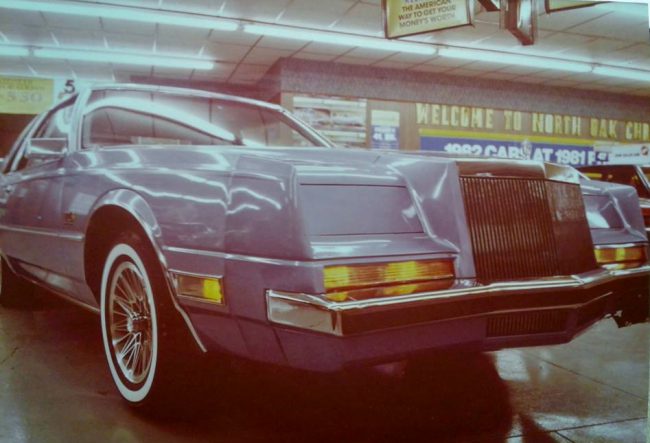
When it was introduced, Jim was immediately smitten, and headed over to the local dealer to check one out. As he relates: “Parked on the showroom floor at North Oak Chrysler-Plymouth on the north side of Chicago in 1981 was this Frank Sinatra edition Imperial. This car was sold to the lawyer of the dealership’s owner. The lawyer was an Imperial collector who also had ’67 Imperial convertible. As far as I know he still owns this car.” Jim himself owned one years later, and drove many back when he worked in the car business in Chicagoland.
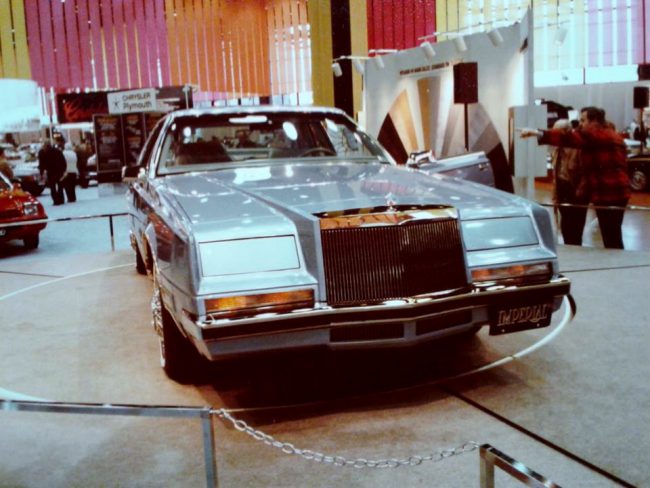
1982 Imperial FS Edition
Yes, Sinatra himself endorsed this car, and the FS edition Imperial came with a selection of his greatest hits on cassette tape, and the metallic blue paint matched his eyes, according to Chrysler Corporation press releases. It was definitely NOT your driver’s ed Dodge Aries.

1982 Cadillac Seville Elegante’ at the Chicago Auto Show
The Big Three had a brief fascination with prewar Rolls-Royce Hooper coachwork, especially the razor edged bustle back rear styling. The 1980 Cadillac Seville was first out of the gate, then the Imperial in ’81, and finally the Continental in model year ’82.

1983 Continental at the Chicago Auto Show
The Seville lasted to 1985 and the Continental to 1987. Both cars’ replacements had much more focus-group-friendly looks.
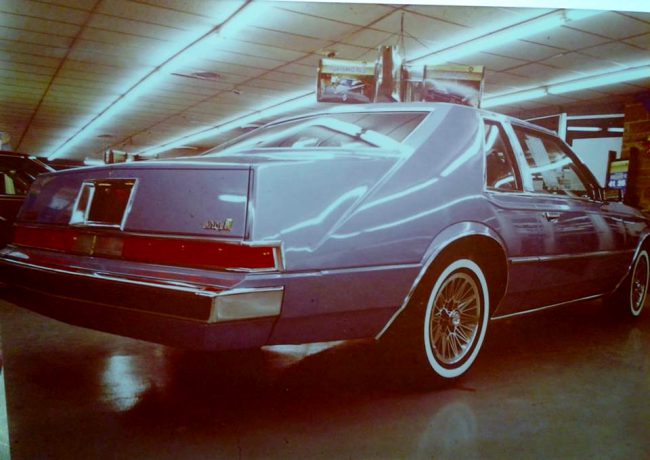
As this is a Retro Show post, we won’t get really deep into the Imperial’s history, but its technology-laden features, particularly its electronic fuel injection system, proved troublesome. A solution wasn’t immediately feasible, and many Imperials had their FI replaced with a carburetor. The car was only sold from 1981-83, with only 1,427 built in ’83. The Frank Sinatra package was not available in the final year of production.

Nightwatch Blue ’83 Imperial spotted by yours truly in October 2012.
I have only seen two or three of them in the last fifteen years, and never an FS. But there’s no denying their razor-sharp American luxury look and plush accommodations!
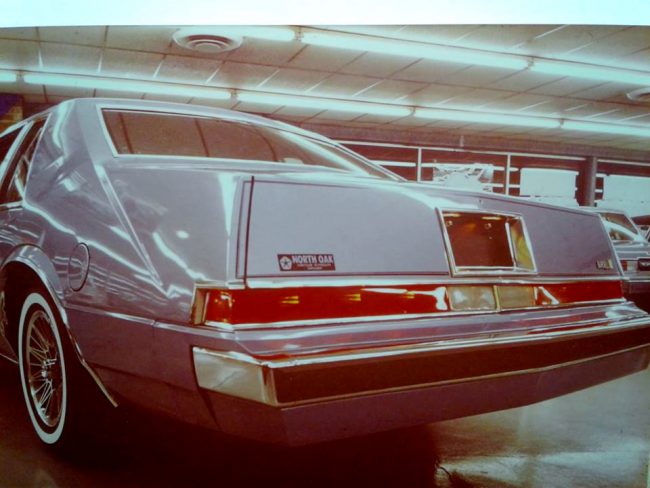







32 Comments
I was amazed that Chrysler could screw up fuel injection on their flagship car in 1981. It is not like it was cutting edge technology, VW put EFI on their lowly Rabbits since 1977, and Cadillac had offered it since the mid 1970s (standard on the Seville in 75). I can only assume the flirtation with bankruptcy had castrated their engineering and testing programs. Frank Sinatra was not a very forgiving man, so I wonder how his friendship with Lido fared after his FS Imperial failed to start a few times, and the car turned out to be a sales disaster. Too bad, because it was much nicer looking than the Lincoln Marks of the time, and by far the nicest of the Detroit bustlebacks of the early 80s..
My father had a 79 Rabbit with EFI…for a few months. I’ll never forget hearing a strange banging sound from outside. As I looked though the window to the driveway I could see him pounding his fists on the dash and steering wheel. His rabbit wouldn’t start, again.
I think it took most automakers until the mid-80’s to sort out the EFI issues and a flagship model with problems is not acceptable.
WRT to the EFI Rabbit: A buddy of mine had a 1978 EFI Scirocco back in 1982… for a few months. Between the leaky aftermarket sunroof (not VWs fault) and the Bosch EFI, he spent a lot of time working on the car or having someone work on the car. In the end, it was far more unreliable than his previous car, a mid 70’s Fiat X-1/9…
I think Dave L is absolutely correct; by the time mid-80’s rolled around, the EFI systems were bulletproof.
I drove a late 70’s Toyota with EFI that the factory was proud enough of to advertise the fact with badges both fore and aft. That car was near bulletproof.
The technical advances that made it to decals and badges over the years could make for an article of its own.
When you consider that Chrysler first offered electronic fuel injection in 1958, their inability to offer a reliable product in 1981 is all the worse.
https://www.allpar.com/cars/desoto/electrojector.html
The 1958 Bendix system was definitely unreliable, and all were converted back to carbs, but in 1958 you could at least say it was an heroic try. Interestingly, the Bendix system was sold/licensed to Bosch, who did perfect it and sold it to automakers around the world.
Let’s not forget how dire was Chrysler’s situation in 1981. Only a short time earlier, when this car was being hatched, the company was literally living on the whim of Congress. It was technically insolvent – Lido’s financial team was essentially stiffing suppliers, coaxing them to carry the notes for a few months. It all hinged on the loan guarantees; and about the only thing more dysfunctional than Chrysler in that year, was Congress.
I had the dubious pleasure of driving a 1980 Chrysler R body taxicab in 1982; and the poor quality assembly and engineering was not to be believed. Door hinges, window-winder mechanisms; outside mirrors…and general poor performance. The only thing solid on those cars was the TorqueFlite transmissions.
It took time and some money, for Chrysler to iron out its quality-control situation. Too, the workforce needed to believe the jobs were actually going to remain; that the place wasn’t about to lock up.
@JPT: Agreed on the workforce back in those days. It’s hard to care about the job when the job may vaporize on you.
My FIL had a Dodge St. Regis back in the day. The company he worked for was a Chrysler supplier, at the time. I think they were one of the ones who got stiffed, too. The car itself was a very nicely equipped vehicle, but the Lean Burn gave him nothing but trouble and some of the electric stuff was problematic, too. They were on a two year company car rotation, so he was glad to see the St. Regis leave his driveway. Unfortunately, it was replaced with a slant six Cordoba that he ended hating (for the same reasons) just as much as the St. Regis…
Oh, gawd, the electrical stuff.
BASIC stuff. On that cab – and other R-bodies in the Yellow Cab Houston fleet – the wipers and headlights would both fail.
Regularly. They both were protected with circuit breakers, good for them – but when it’s pouring in the rainy season, and you’re on fast-moving gridlock on the Eastex Freeway…with a passenger from the airport…it’s not a good time to lose wipers.
I remember Patrick Bedard chiding the New Chrysler Corporation about that time – Lido’s team pink-slipped almost the entire engineering team, a week before the Ks started rolling out. They had to, they said – no money.
Well, that may have been true; but it was a bad time to be without problem solvers, even temporarily. Lean Burn and then the new fuel injection systems, were in need of a LOT of fixing. Bedard, who was a young engineer for Lynn Townsend’s Chrysler in the early 1960s, recalled how he was laid off during the 1964 brush-with-bankruptcy.
It didn’t work so well for ChryCo then, and Bedard expected a similarly bad outcome.
He was wrong in the bigger picture, but, short-term, the problems that came of those cost-cutting schemes cost Chrysler most of its fleet business.
He was probably right on both counts, its not like Chrysler is a thriving, independent American car company these days either…….
I’m gonna get picky with the nits, here:
VW’s Rabbit system was MECHANICAL. NOT electronic. The buff books chided VW for avoiding the EFI system they’d used in the last years on the Beetle; but in those pre-silicon years, electronic reliability was wanting. I’m not an engineer, but I recall a discussion about the microvoltages involved in EFI, or the variable-venturi carbs. And of course Lean Burn.
Although VW had a lot of problems in those days, and on to today, even, their choice of using Bosch mechanical FI was a sound one. And it may be how it was VW survived to this day – through their early-1990s crisis that had VW sales in four-figures for a couple of years.
It was mechanical? Crap, my memory must be going. OTOH, it was in the last century…
Bosch K-Jetronic.
https://en.wikipedia.org/wiki/Jetronic
For further reading:
http://autoweek.com/article/wait-theres-more/ultra-rare-treasure-discovered-california-wrecking-yard-frank-sinatra
http://www.thetruthaboutcars.com/2015/03/last-emperor-1983-chrysler-imperial/
thanks for the link to the murilee martin piece. in my mind, he is one of the all-time great auto journalists. his down on the street and junkyard series set the standard for writing about old cars.
Agreed. What would it take to get him over here?
I enjoyed his stuff on Jellopicnic before that site went full estrogen….. Though I do curse him for introducing the term “malaise” to automotive journalism……
It was Jimmy Carter who gave us malaise in every sense of the term.
Yeah, but it was Murilee who made it the “Ms.Dash” flavor enhancer for every hack wanna be auto “journalist”
1966 GTO-malaise
1977 Trans Am-malaise
1993 Ford Escort-malaise
Malaise, malaise, malaise, malaise…..
Its almost as bad as “hoon”……which I also hate.
Carmine: I am right with you on people using “Malaise” on anything from a 1970 LTD to a 1995 Aurora. I HATE it.
Sorry, anything after say 1982 is just stupid. And the ’90s? Give me a friggin’ break…
If you want to talk about malaise, let me show you some crossovers…ooh I mean combovers. 🙂
“thanks for the link to the murilee martin piece. in my mind, he is one of the all-time great auto journalists. his down on the street and junkyard series set the standard for writing about old cars.”
I have nothing at all against Murilee Martin, but what are you talking about? He picked eclectic topics to document, but the ‘standard for writing about old cars’ was not set by his photo captions.
Well… it was good enough for Paul to flat out steal for Curbside Classics.
Thats a pretty low bar though……
CC stuff from PN only looked like a junkyard vehicle when he was sneering at a domestic. A lazy way to justify “deadly sin” without the hard work on research. Luckily JPC did the big writeup on the Imperial so Paul could only call it a DS in the comments
You could chose either cassette or 8track for Frank’s greatest hits on the FS Imperial. I’m guessing you got whatever went with the radio choice. The Imperials were built in Windsor from what I recall and the ads boasted about the extra time that went into finishing the Imperial.
As a Gen X’er I always loved that model of the Seville. My take is that when comparing the three, there was a level of fit and finish and detail in the Cadillac that just was not in the Lincoln or Chrysler. My dad was the sales rep for a small west Michigan manufacturer and occasionally I would get to ride in his boss’s Seville when they would bring me out to lunch with the two of them. So much velour and plushness. Also, (if memory serves me correctly) the car was just silent inside.
Shortly after buying my ’80 Cadillac Fleetwood Brougham Coupe, I met up with a friend who has a bustle back Imperial, and we drove each other’s cars to compare. Even though these two cars were designed on very different platforms and aimed at different markets, there are a lot of similarities. They were much closer in size, in and out, than I would have expected. His Imperial has working FI, and I would give it a slight performance edgs.
Out of the three cars mentioned in the post, this is my fave of the bustlebacks. The sophomore Cadillac Seville was just odd to me, but at that time I was not aware of the 1930’s Hooper influence. As usual, I felt that Chrysler and Ford were playing perpetual catch-up with GM by releasing their bustlebacks shortly after. At that time, GM could get away with releasing a car like that, because GM. Had Ford or Mopar done it first, it would have likely fallen flat on their face(s), IMO.
Regardless of introduction dates and especially as time goes on, I find the Impy far more delightful than the other two. At the time, I thought that Chrysler did a better job of the “sheer” look than either Ford or GM; too bad the electronics and assembly were such a mess.
I love that Iacocca went back to the Lincoln Mark well so early in his Chrysler tenor. The special touch of the real crystal hood ornament and an actual Frank Sinatra package was just the ticket. A ticket that might have gotten punched more if the rat pack fans could have believed the Chrysler would survive. It was a bigger gamble than the K car for the buyer. Iacocca is/was also just the guy to tie in to the rat pack, being Italian and of that generation. Iacocca even had a four door limo coach built for Frank Sinatra
This deluxe version of the Volare’ also deserves mention. It transitions to a luxury application as least as well visually as the Mark VII. When you think of all the pathetic luxury versions of Valiants tried overseas like the Chrysler by Chrysler in Australia or that silly Dodge Dart in Spain, you see what could of happened. Volare’ gets ripped rightly for the rusty fenders on the first few but the Fifth Avenue proved the substance was there for luxury.
From what I recall, the Imperial was already under development when Lido joined Chrysler, I think he wanted to stop it, but too much had already been spent on its development, I recall that he talked about it briefly in his book, about how tone deaf it would look for a company trying to secure gov loans for its survival while at the same time introducing a luxury coupe…..during a shitty economy.
I worked at the Windsor plant as a student during the 1982 and shortened 1983 model year, and managed to help assemble a few. They were a bit of a bugger, as the parts were different than the other M bodies, so it was a bit of a scramble to get the right parts lined up in the time allotted. I much preferred a loaded Cordoba or Mirada with the 318, leather guts, buckets, etc., as a long term proposition. Around half of the Cordoba’s/Mirada’s seemed to be coming off of the line with the slant six in those fuel crisis days. The Imperial’s went through a special pre-shipping QA process, and I recall a lot of extra work being done before they were shipped to the dealers.
Thank you for sharing this… I wish I had access to more of this firsthand information.